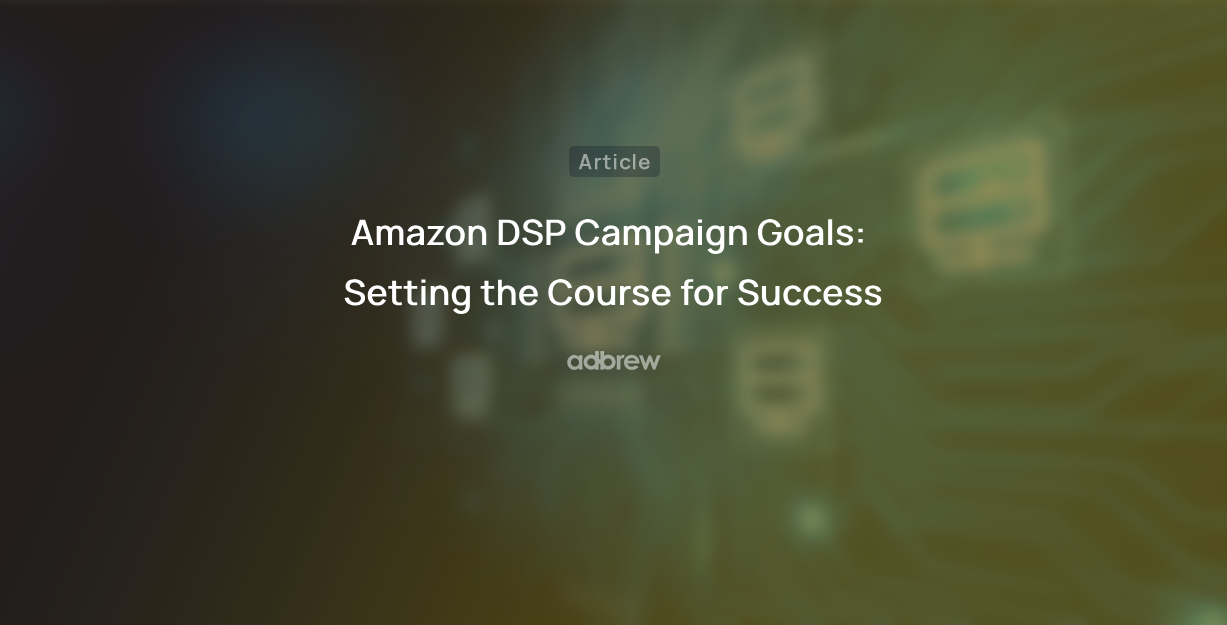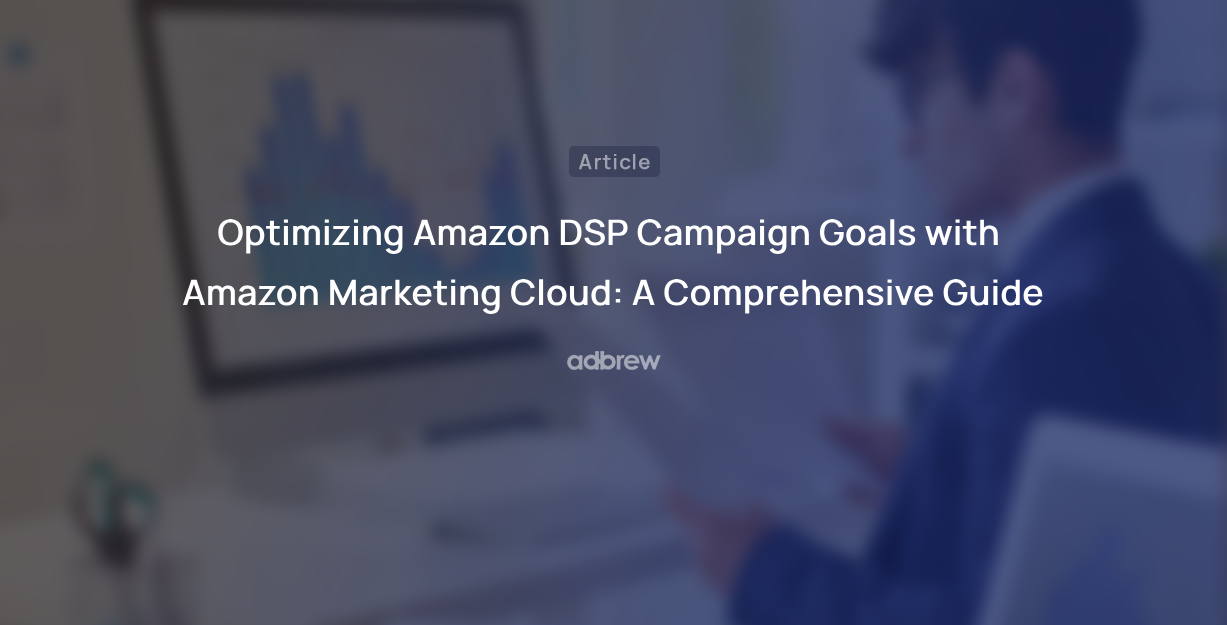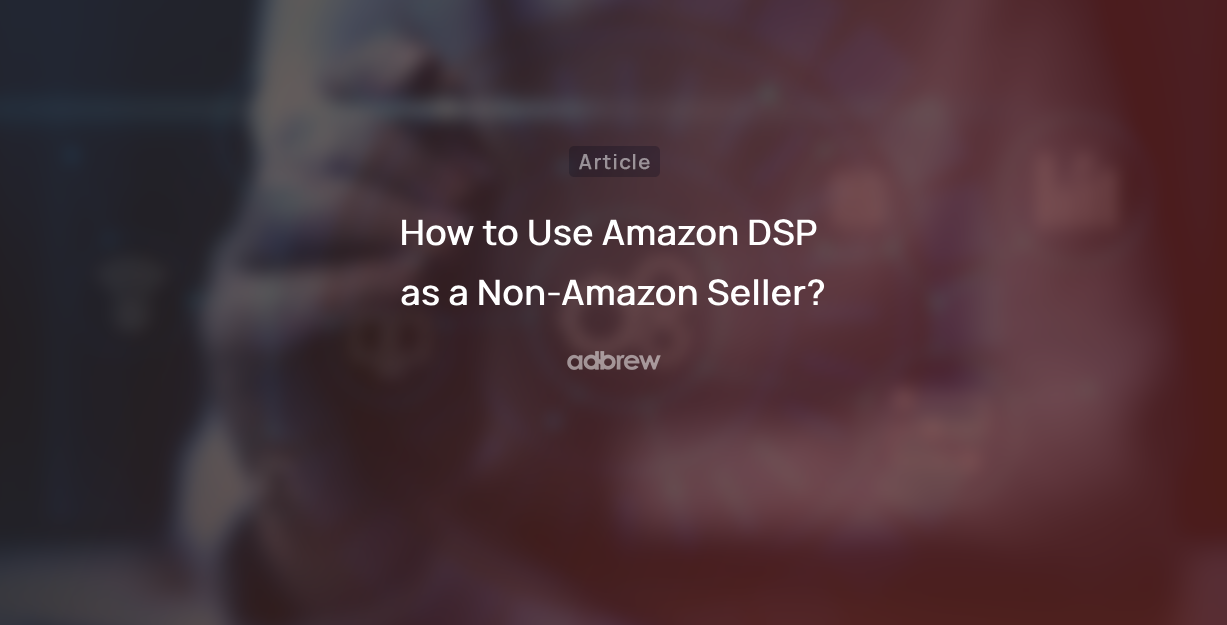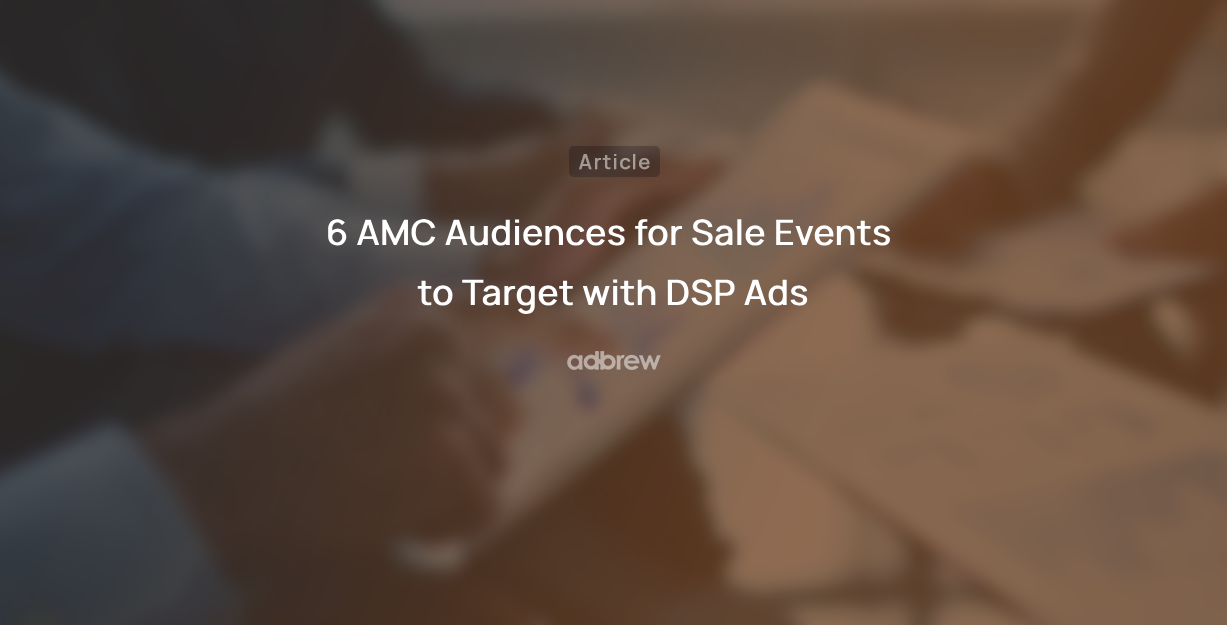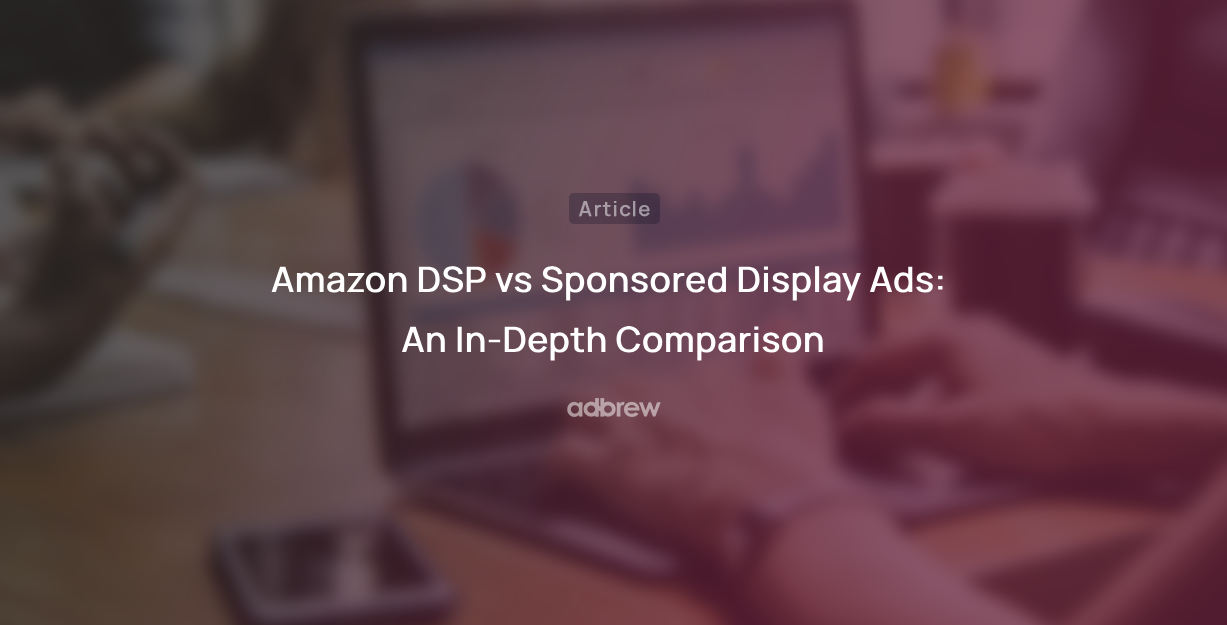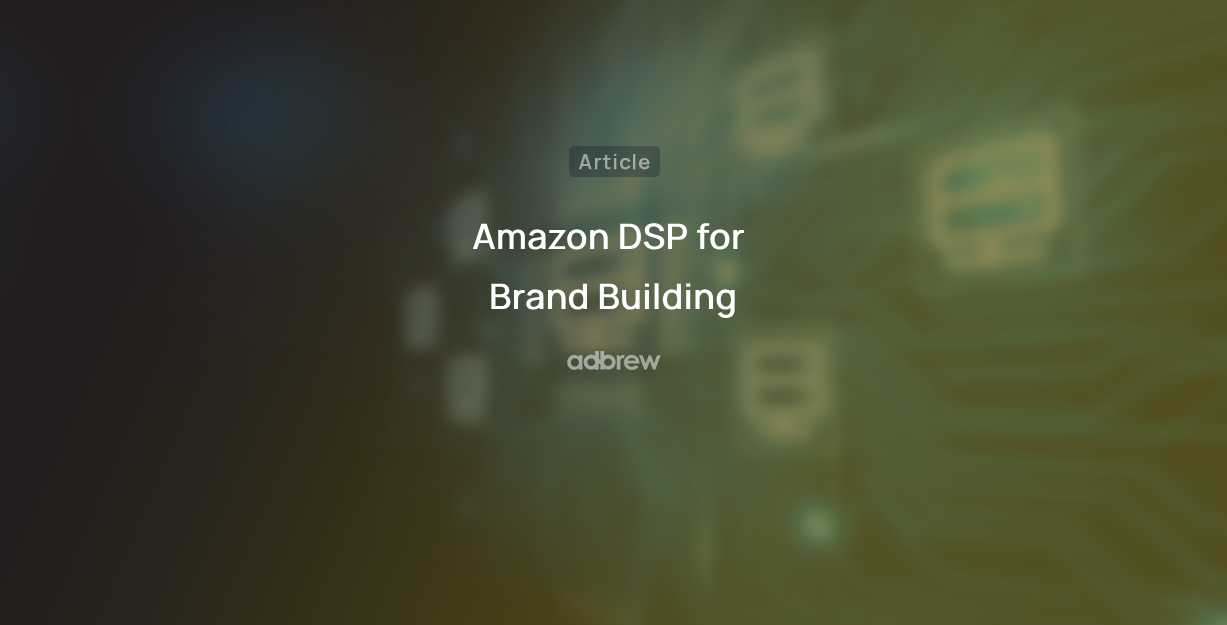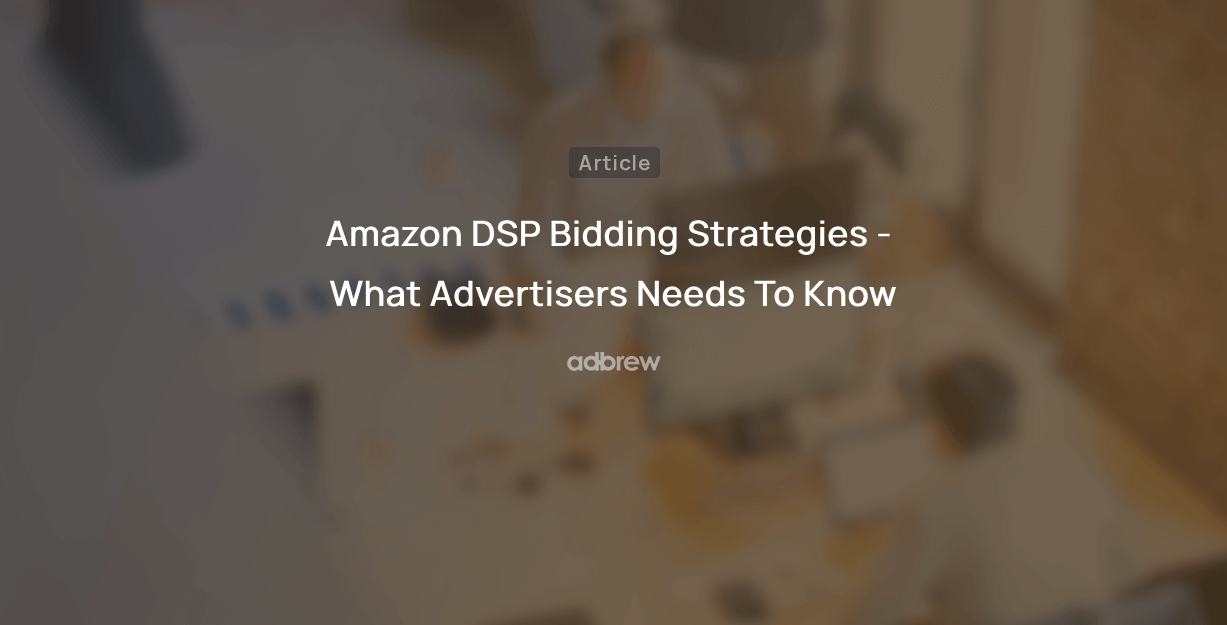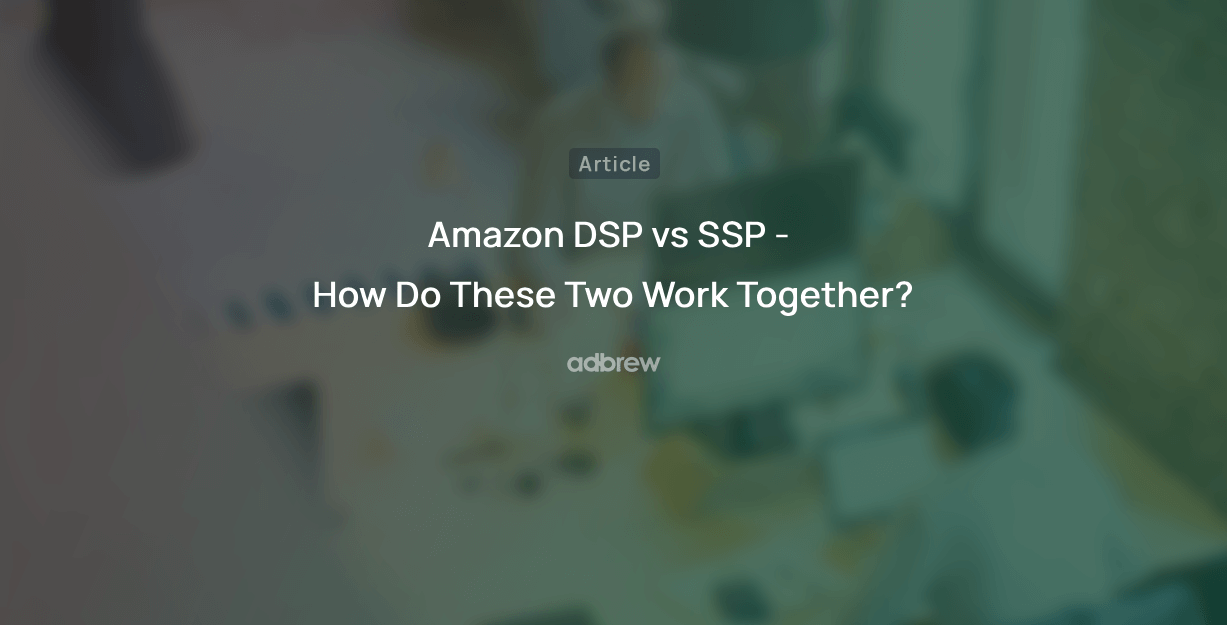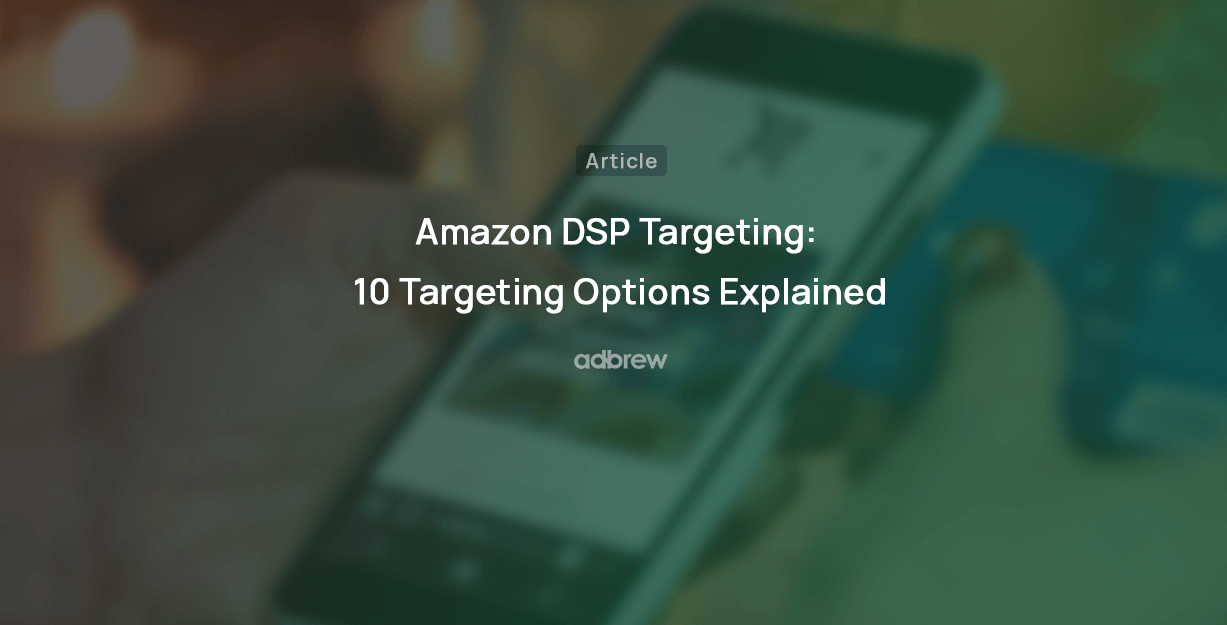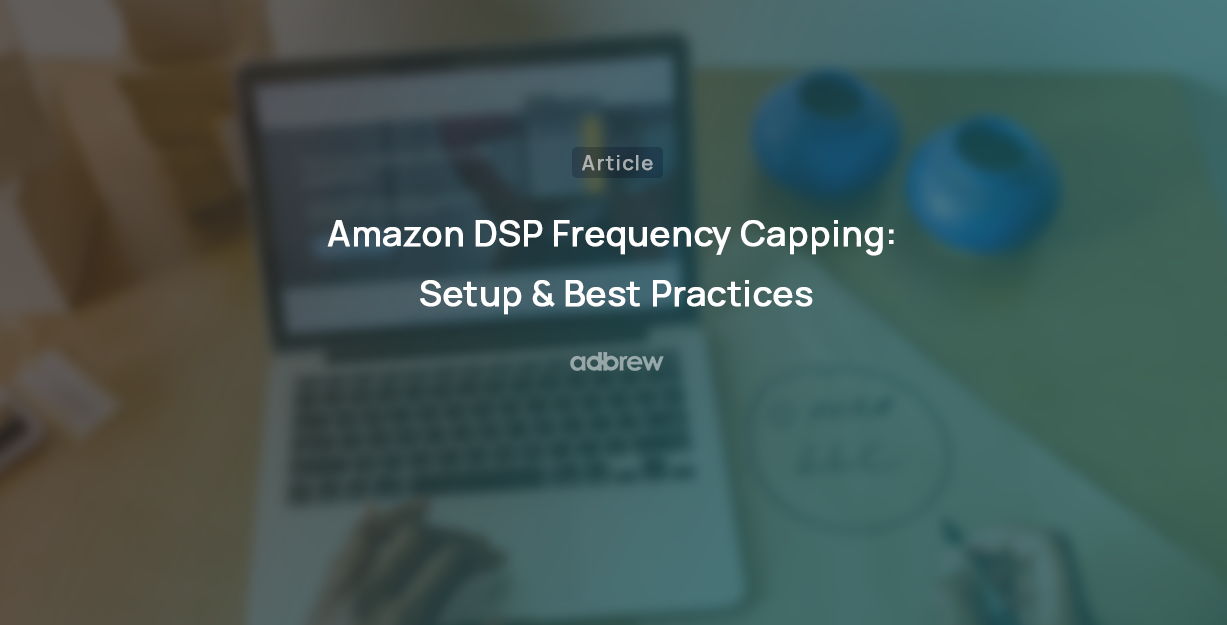
Are you an e-commerce business owner looking for new and interesting methods to reach out to potential customers?
Look no further than the Amazon DSP platform.
In this blog post, we will discuss what Amazon DSP is, how it works, and how you can use it for your brand.
What is Amazon DSP?
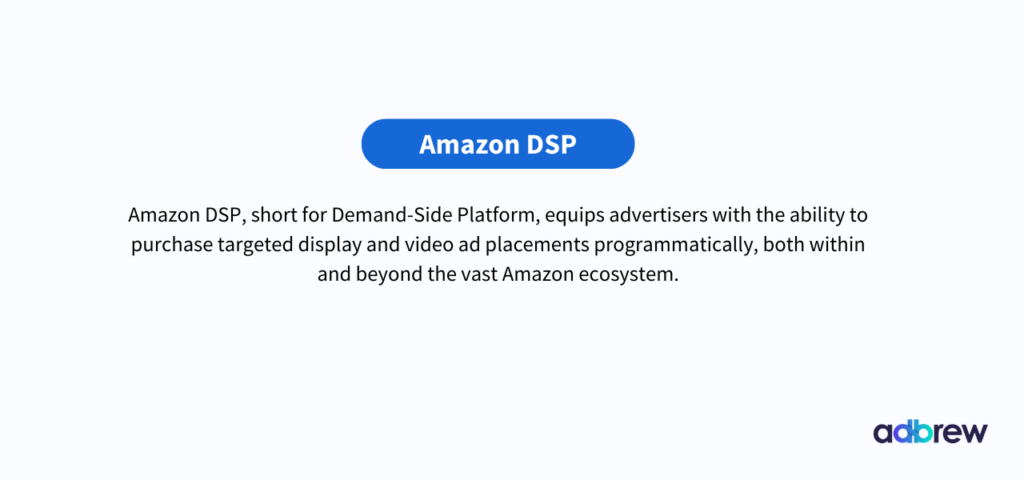
Amazon DSP, short for Demand-Side Platform, equips advertisers with the ability to purchase targeted display and video ad placements programmatically, both within and beyond the vast Amazon ecosystem. This flexible solution unlocks a realm of possibilities, empowering you to:
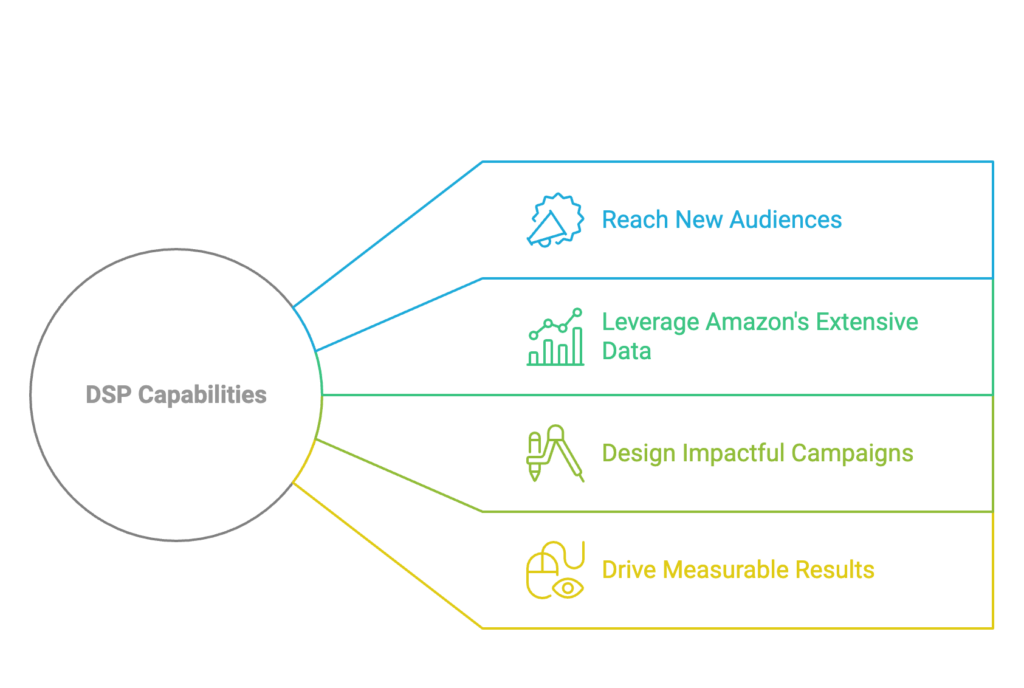
- Reach new audiences across the web and various devices, extending your reach far beyond Amazon shoppers.
- Leverage Amazon’s extensive data to pinpoint your ideal customers with laser-sharp precision based on demographics, interests, and shopping behavior.
- Design impactful campaigns using a comprehensive suite of targeting options, ad formats, and reporting tools.
- Drive measurable results from brand awareness to increased sales, with granular insights to optimize your spending and maximize return on investment.
Think of Amazon DSP as your key to unlocking new customer segments and growing your brand beyond the Amazon marketplace. It’s an integral part of the Amazon Advertising Platform, offering unparalleled access, control, and data-driven insights to elevate your advertising game.
Key terminologies related to DSP
Understanding key terminologies related to Amazon DSP (Demand-Side Platform) is essential for effectively navigating and utilizing programmatic advertising. Here are some key DSP terminologies:
- Real-Time Bidding (RTB): RTB is a method used in programmatic advertising where ad impressions are bought and sold in real-time auctions. Advertisers participate in these auctions through the DSP platform, placing bids to win ad impressions that match their targeting criteria. The highest bidder usually wins the first placement.
- Programmatic Buying: Programmatic buying refers to the automated process of purchasing digital ad impressions. Advertisers use Amazon DSPs to set their targeting parameters, budgets, and bidding strategies, and the platform executes the buying process in real time based on these settings.
- Ad Exchange: An ad exchange is a digital marketplace where publishers make their ad inventory available for purchase. Amazon DSPs connect to ad exchanges, enabling advertisers to access and bid on ad impressions from multiple publishers simultaneously. Ad exchanges facilitate the buying and selling of ad inventory through real-time auctions.
- Targeting: Amazon DSPs offer various targeting options to reach specific audiences. Targeting parameters include demographics (age, gender, location), interests, behavior, contextual relevance, and more. By defining targeting criteria, advertisers can reach their intended audience segments more precisely.
- Impressions: Impressions refer to the number of times an ad is displayed to users. Amazon DSPs track impressions to measure the reach and visibility of advertising campaigns. Advertisers can use impression data to evaluate the performance and effectiveness of their ad campaigns.
- Retargeting: Retargeting, also known as remarketing, is a targeting strategy where advertisers show ads to users who have previously interacted with their product or brand.
- Frequency Capping: Frequency capping allows advertisers to limit the number of times an ad is shown to an individual user within a specific period. This helps prevent ad fatigue and ensures that users are not repeatedly exposed to the same ad, improving overall campaign performance and user experience.
- Attribution: Attribution in Amazon DSP refers to the process of assigning credit to different touchpoints in the user journey that lead to a desired action.
Supply Sources in Amazon DSP
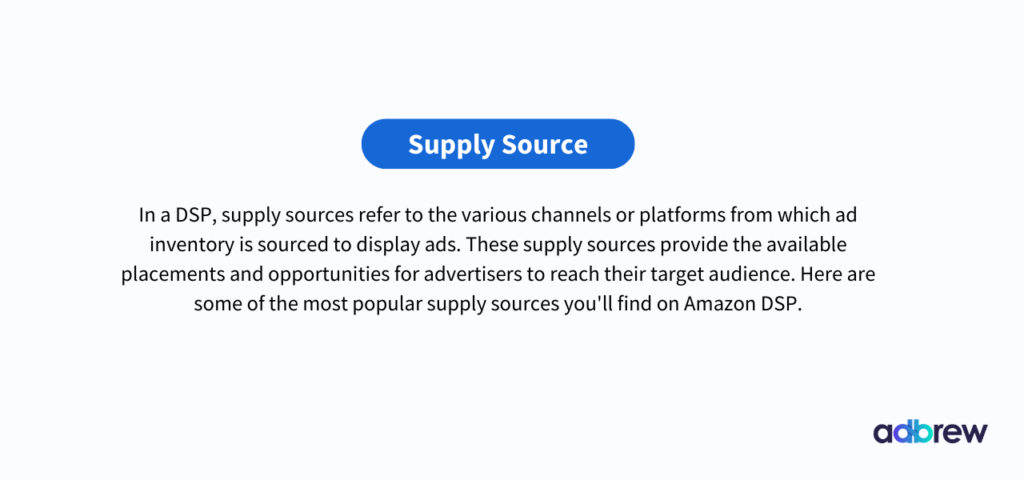
In a DSP, supply sources refer to the various channels or platforms from which ad inventory is sourced to display ads. These supply sources provide the available placements and opportunities for advertisers to reach their target audience. Here are some of the most popular supply sources you’ll find on Amazon DSP.
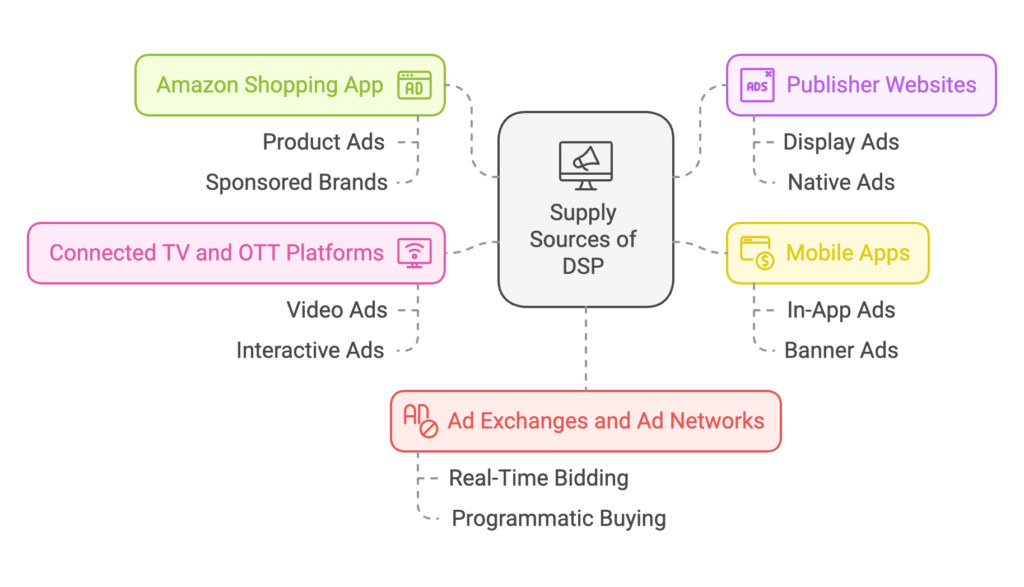
- Amazon Shopping App: Amazon DSP gives advertisers access to advertise across the different placements on the Amazon shopping app.
- Publisher Websites: This includes various websites across different industries and niches. Publishers make their website inventory available for advertising through the DSP. Advertisers can select specific websites or categories of websites to display their ads.
- Mobile Apps: Advertisers can show their ads to users using different types of mobile applications, such as gaming, social media, news, entertainment, or utility apps.
- Connected TV and OTT Platforms: With the rise in streaming services and connected TV devices, supply sources now include platforms that offer ad placements on connected TVs and over-the-top (OTT) devices. Advertisers can target users streaming content on platforms like smart TVs, streaming devices, or OTT apps.
- Ad Exchanges and Ad Networks: Amazon DSP has access to several ad exchanges and ad networks, which serve as intermediaries between publishers and advertisers. Ad exchanges aggregate ad inventory from multiple sources, while ad networks represent a network of websites or publishers. These platforms offer a broad range of ad placements and inventory options.
Various Components of the Amazon DSP Platform
The Amazon DSP Platform encompasses several essential components that collectively drive its functionality. Here is a quick introduction to the different parts:
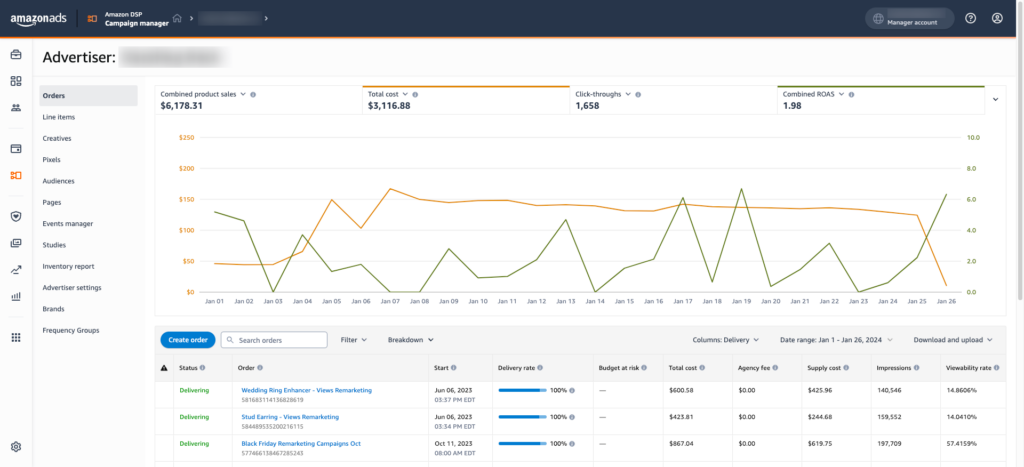
- Dashboard: At the core of the DSP platform lies a centralized dashboard that serves as the control center for managing your advertising campaigns. This dashboard overviews key metrics, campaign performance, and account settings in a user-friendly display.
- Orders: An order is a collection of line items that belong to the same campaign and share standard settings. It provides a higher-level organizational structure to manage multiple line items together. You can think of it as a campaign similar to how we use it for Sponsored ads.
- Line Items: A line item represents a specific ad placement or set within an advertising campaign. It contains information about the targeting criteria, creative assets, bid strategy, budget, and flight dates. You can think of it as ad groups similar to how we use them for Sponsored ads.
- Targeting: DSP platforms offer sophisticated targeting capabilities to reach your desired audience. You can refine your target audience through intuitive interfaces based on demographics, location, interests, behavior, and contextual relevance.
- Ad Formats and Creatives: DSPs support various ad formats, from traditional display banners to engaging video ads and native ad placements. The platform allows you to effortlessly upload, manage, and optimize your creative assets, such as images, videos, headlines, and ad copy, ensuring your campaigns resonate with your target audience.
- Inventory and Publisher Selection: DSP platforms provide access to various ad inventory sources, including popular publishers and ad exchanges. You can hand-pick specific publishers to display your ads or utilize programmatic buying to seamlessly reach audiences across various websites, mobile apps, and digital channels.
Ready to get started with Adbrew?
Adbrew provides cutting-edge automation, expertly curated strategies, and data-driven insights to manage your DSP campaigns
Amazon DSP Ad Types
When exploring Amazon DSP advertising, it’s important to grasp the four main ad types and how to use them strategically for successful campaigns.
- Video Ads: Under the Video Ads category, Amazon DSP offers two distinct types. The first, Over-the-top (OTT) Ads, focuses on raising brand awareness through full-screen video placements within high-quality streaming content. These are non-clickable ads ideal for building brand recognition. On the other hand, Online Video (OLV) Ads can redirect users to Amazon product detail pages or a brand’s website, making them an effective choice for boosting brand visibility and promoting specific products.
- Dynamic Responsive eCommerce Creatives (RECs) Ads: Dynamic Responsive e-commerce Creatives (RECs) revolutionize traditional dynamic e-commerce ads. Instead of manually creating multiple ad variants, RECs automate the process by generating eCommerce display ad creatives featuring up to 20 products.
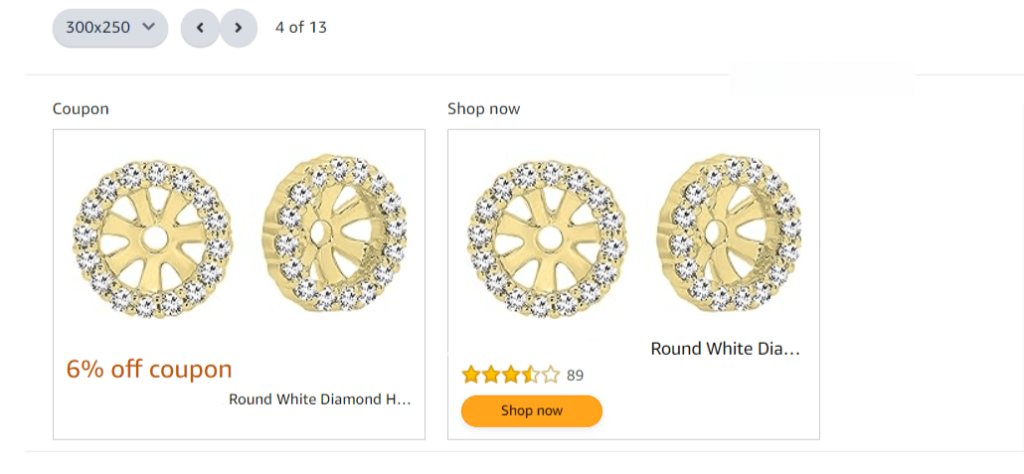
- Audio Ads: Amazon DSP’s Audio Ads offer a unique opportunity to engage audiences on Amazon Music and third-party Amazon publisher services. These 10 to 30-second audio snippets come at a cost-per-thousand-impression (CPM) rate, making them a preferred choice for sellers. They have been proven to outperform industry benchmarks, boasting higher ad awareness, favorability, and purchase intent.

Image Source – Amazon
- Static Ads: In Static Ads, you have Image Ads and Mobile Banner Ads. Image Ads are straightforward visuals that are effective for mid- to upper-funnel advertising. They can include compelling calls to action to drive users to specific product detail page, store pages, or landing pages. Mobile Banner Ads, appearing at the top and bottom of mobile screens during website and app browsing, offer a non-intrusive way to reach mobile users in line with their preferences.

Image Source – Amazon
Types of DSP Audiences
Amazon DSP offers a wide range of audience targeting options that brands can utilize to effectively promote their products. Here are the various types of audience targeting available in Amazon DSP :
- In-Market Targeting: Reach consumers who frequently purchase from specific categories, such as electronics, kitchen goods, or women’s clothing.
- Life Event Targeting: Target ads to audiences in specific life stages, such as college students, new homeowners, or expecting mothers.
- Behavioral Targeting: Engage consumers who have exhibited specific behaviors, such as browsing or clicking on related content.
- Video Completion Targeting: Target users based on their engagement with explainer videos, ensuring your ads reach those who have watched all or part of the content.
- Demographic Targeting: Reach consumers based on age, gender, household income, education level, and other relevant demographic characteristics.
- Device Targeting: Tailor ads to specific users using a particular operating system, device, etc.
- Contextual Targeting: Display ads based on the real-time content users are browsing, ensuring relevance and contextual alignment.
- Retargeting: Show ads to users who have viewed or purchased a product on Amazon.
- Advertiser Audience: Create custom audiences by uploading first-party data, enabling targeting based on offline identifiers, and reaching your existing customer base.
Additionally, Amazon DSP offers Audience Lookalikes, allowing you to expand your reach beyond your existing audience by targeting users who share similar characteristics and affinities with your chosen audience.
Amazon DSP in the Marketing funnel
Amazon DSP (Demand-Side Platform) can play a significant role in various stages of the marketing funnel, enabling advertisers to create awareness, increase consideration, and drive conversions. Here’s a quick overview of how Amazon DSP can be utilized across different stages of the marketing funnel:
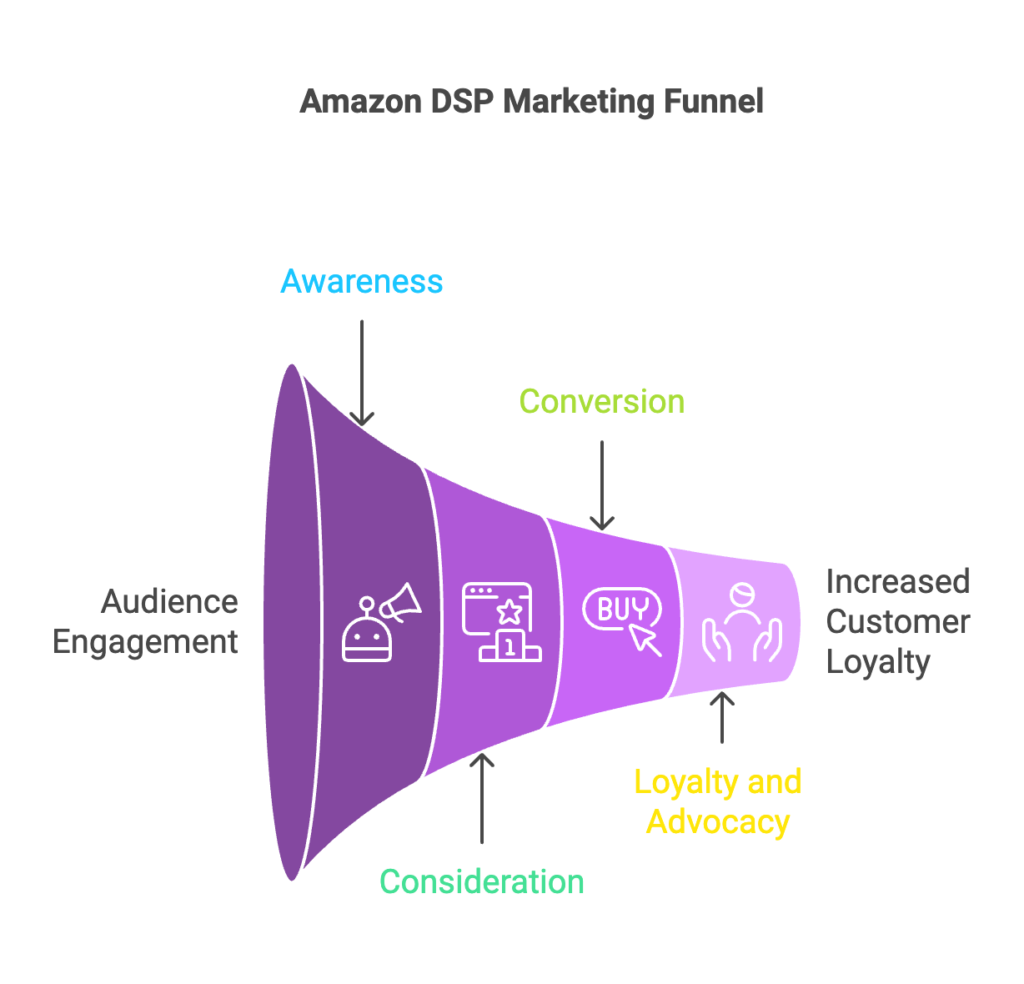
- Awareness Stage: At the top of the marketing funnel, the goal is to create brand awareness and capture the attention of potential customers. Amazon DSP offers robust targeting options, allowing advertisers to reach specific audience segments based on demographics, interests, and behaviors. By serving display or video ads to relevant audiences across the web, advertisers can effectively introduce their brand or product to a wide range of potential customers.
- Consideration Stage: Consumers actively research and evaluate products or services in the consideration stage. Amazon DSP can retarget users interested in a particular brand or product. By strategically placing ads on relevant websites or apps that these users visit, advertisers can reinforce their brand messaging, highlight product features, and drive consideration for their offerings.
- Conversion Stage: The conversion stage focuses on turning potential customers into actual buyers. Amazon DSP can help drive conversions by retargeting users with strong intent or engaging with specific products or categories. By delivering personalized ads to these users and showcasing relevant offers or promotions, advertisers can encourage them to take the desired action, such as purchasing or signing up for a service.
- Loyalty and Advocacy Stage: After a successful conversion, the marketing funnel extends to fostering customer loyalty and advocacy. Amazon DSP allows advertisers to engage with existing customers by showcasing relevant upsell or cross-sell offers, providing exclusive discounts, or promoting loyalty programs. By targeting these customers with personalized messaging, advertisers can nurture long-term relationships, encourage repeat purchases, and leverage satisfied customers to become brand advocates.
Similarities between DSP and Sponsored Display
DSP (Demand-Side Platform) and Sponsored Display are both different ad types offered by Amazon Advertising. Here are some similarities between both the ad types:
- Advertising on Amazon: Both DSP and Sponsored Display allow advertisers to promote their products and brands on the Amazon platform, targeting shoppers on Amazon.
- Targeting Options: DSP and Sponsored Display offer various targeting options to reach specific audiences. Advertisers can target based on customer demographics, interests, shopping behavior, and other relevant data.
- Automated Advertising: DSP and Sponsored Display leverage automation to optimize advertising campaigns. They use algorithms and machine learning to deliver ads to the most relevant audiences and achieve campaign goals.
- Ad Formats: DSP and Sponsored Display support multiple ad formats, including product ads, banner ads, and native ads. Advertisers can choose the configuration that best suits their campaign goals and target audience.
- Reporting and Analytics: DSP and Sponsored Display provide advertisers with reporting and analytics tools to measure campaign performance. Advertisers can track metrics such as impressions, clicks, conversions, and return on ad spend (ROAS) to evaluate the effectiveness of their advertising efforts.
Differences between DSP and Sponsored Display
Although DSP and Sponsored Display share similarities, they exhibit several differences that make them suitable for distinct use cases.
- Targeting Options: DSP offers advanced targeting capabilities, allowing advertisers to leverage first-party and third-party data to reach specific audiences based on demographics, behavior, interests, lifestyle, and life events, among other factors. Sponsored Display offers targeting for products or interests, primarily relying on Amazon’s customer data.
- Campaign Control and Customization: DSP provides advertisers with more control and customization options. They can set campaign objectives, budgets, and bidding strategies and have more flexibility in creative design and ad formats. Sponsored Display, on the other hand, has limited customization options, with predefined ad templates and less control over campaign settings.
- Minimum Investment: DSP typically requires a higher minimum monthly ad spend of $10,000 for self-service and $50,000 for managed service, while Sponsored Display has a minimum spend requirement of $1 per day.
- Reporting and Analytics: DSP offers more robust reporting and analytics capabilities, allowing advertisers to track and analyze campaign performance across different channels and platforms. Sponsored Display provides basic performance metrics for Amazon advertising, such as impressions, clicks, and attributed sales.
Overall, DSP provides a more comprehensive and flexible advertising solution for reaching audiences on and off Amazon, while Sponsored Display offers a more streamlined and Amazon-focused advertising option within the platform’s ecosystem.
Eligibility criteria for Amazon DSP
Brands can access Amazon DSP through two methods:
- Amazon Managed: This option is ideal for those with limited programmatic advertising experience. Amazon offers a directly managed service that includes consultative support. To avail of this service, brands must commit to a minimum spending of $35,000.
- Managed Self-Service: This alternative is exclusively available to Amazon Agency Partners. Brands opting for this method can enjoy a higher level of campaign control. Collaborating with an Amazon Ads Partner allows advertisers to bypass the minimum spending requirement, providing greater budget flexibility.
Specific eligibility requirements and access to the Amazon Demand Side platform (DSP) may be subject to change. For detailed and up-to-date information on eligibility, it is recommended to contact Amazon Advertising directly or consult with the authorized partners.
Ready to get started with Adbrew?
Adbrew provides cutting-edge automation, expertly curated strategies, and data-driven insights for brands to thrive on Amazon.
Conclusion
Although Amazon Demand Side Platform might not be the right fit for new or smaller sellers, it emerges as a robust solution for established sellers equipped with a significant advertising budget, aiming to expand their brand presence. Through the effective utilization of Amazon’s first-party data, DSP offers an excellent platform for engaging with shoppers throughout various stages of the purchasing journey.
Frequently Asked Questions

What types of creatives work best with Amazon DSP?
High-quality display and video creatives with clear messaging and a strong call-to-action work best for engaging audiences.
Recent Posts
Amazon DSP Ads Optimization Software

Related Blogs
With the advent of Amazon Marketing Cloud (AMC), optimizing ad campaigns has become more versatile than ever. One notable feature […]
Amazon DSP, a Demand-Side Platform, allows advertisers to target audiences accurately using Amazon’s extensive shopper data. But before starting a […]
Amazon’s Demand-Side Platform (DSP) has become a game-changer for advertisers seeking to reach a massive audience of engaged shoppers. However, […]
Having spent considerable time working with Amazon DSP ads, we’ve observed a common challenge: achieving and measuring optimal results from […]
Are you a non-Amazon seller looking to tap into the power of Amazon’s advertising network? Amazon DSP, their Demand-Side Platform, […]
Sale events are all about reaching the right customers at the right time. But with so many promotions bombarding shoppers, […]
Amazon offers two different display advertising options for sellers: Sponsored Display ads and Amazon DSP ads. Selecting the right one […]
In today’s digital world, building a strong online brand is crucial for businesses of all sizes. While Amazon advertising solutions […]
Amazon Demand Side Platform unlocks programmatic advertising across many channels in the vast Amazon ecosystem and beyond, but often gets […]
Feeling trapped in the challenges of Amazon Sponsored Ads? Limited to engaging only with customers actively searching for your brand […]
If you are selling on Amazon, having a well-crafted remarketing strategy in place becomes crucial. Imagine re-engaging with potential customers […]
In digital advertising, Amazon DSP has emerged as a powerful tool for businesses to connect with their target audience and […]
Unlike Sponsored Ads, Amazon DSP offers the flexibility to run campaigns that guide users to either Amazon or non-Amazon destinations. […]
Whether you’re an advertiser seeking to connect with engaged shoppers worldwide or a publisher looking to monetize your ad inventory […]
Are you just starting with Amazon DSP (demand side platform) and feeling a bit lost in how to create Amazon DSP campaigns? We […]
Are you an e-commerce business owner looking for new and interesting methods to reach out to potential customers? Look no […]
We all utilize many different DSP ad types and targeting options available to advertisers in Amazon DSP. But how do […]
Amazon DSP (demand side platform) provides a multitude of targeting options, ranging from customer demographics, and behavioral targeting to contextual […]
Every advertiser wants their ads to reach a broad audience. However, showing an ad too many times to one person […]
With more and more shoppers turning to Amazon for online shopping, it is obvious why brands don’t want to limit […]



